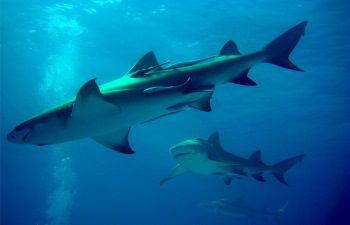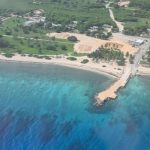DoE calls for photos of Cayman’s ocean predators
(CNS): As part of an ongoing research project monitoring the shark, grouper and snapper populations around the Cayman Islands, the Department of Environment is calling on divers, snorkellers and fishermen to upload any pictures they snap of these ocean predators to Facebook and Twitter, using the hashtag #SpotThatCayFish, to help scientists in their work. The citizen science programme will give people the opportunity to get involved and be part of research and conservation efforts to protect these increasingly threatened but critically important fish.
Sharks and large predatory fish, like groupers, mutton snappers and even lagoon snappers, play a key role in coral reef ecosystems because they control the numbers of smaller predators.
“If there are too few top predators, it will have cascading effects down the food web disturbing the natural balance, which will impact local fishing negatively,” said DoE Research Officer John Bothwell. “It’s why, under the National Conservation Law, sharks are now completely protected everywhere in Cayman waters.”
The research work is being conducted by the DoE in partnership with Marine Conservation International (MCI), funded largely by the UK Darwin Plus Award, and is part of the goal to protect the marine predators and restoring key their habitats. The project is also supported by the money collected by CIB’s White Tip beer.
Sharks and large predatory fish have declined in numbers worldwide as well as in the Cayman Islands.
“Sharks in particular are vulnerable to fishing because they grow very slowly, mature late, and generally have only a few pups per birth,” said MCI’s Johanna Kohler. Therefore, monitoring of top marine predator populations is crucial to ensure healthy reefs and sustainable fishing in the Cayman Islands.
To be able to understand the movement and seasonality of the fish, people providing photos should include the dive or snorkel site, date, time of day and, for their part in the programme to be acknowledges, their name in the post on #SpotThatCayFish.
“In the next few weeks, we will distribute postcards to diving companies around Cayman so that visiting divers and snorkelers can also become involved,” Kohler added.
The photos from the Citizen Science Programme will be used to identify individual fish, which allows the researchers to estimate their numbers, habitat and home range.
“Divers and snorkelers take wonderful underwater photos and this is a chance for them to help Cayman’s marine environment themselves by uploading their photos using the SpotThatCayFish – hashtag. We will then catalogue the images of sharks, groupers, and snappers to place and time and then post the results on Facebook and Twitter,” Kohler explained.
To gather even more information, the research team has tagged dorsal fins of some sharks with orange tags, which can be easily seen by divers or snorkellers, including acoustic tags in the sharks and larger fish to track where they move to overtime. The pings emitted by the tags are recorded by acoustic receivers around each of the Cayman Islands.
Some fish, like lagoon snappers, will be tagged with beads, which are placed in front of their dorsal fin so they are also easily seen by divers, snorkellers, and fishermen.
“Lagoon snapper are a species of particular interest because they are heavily fished during their spawning season and a lot of concerned fishermen have been asking for sustainable management to be put in place for this species. As part of the project DoE and MCI will be talking with fishermen about that – what they catch, where, when and how much, and what they think good management options might be — but we also need more information than we can get from the fishermen alone,” added Bothwell.
Anyone who catches a tagged fish and doesn’t have a camera is asked to contact he DoE and there is also a reward for the return of acoustic tags.
The team can be contacted by telephoning 949-8469 and by email to DoE@gov.ky or mauvis.gore.mci@gmail.com. Pictures of any sharks or fish, especially those with tags, can be uploaded with the hashtag #SpotThatCayFish.”
For more information about this research and the reward programme, visit www.doe.ky and www.marineconservationinternational.org.
For updates on the Top Marine Predator Project and the Citizen Science Programme visit and like the Facebook page “Shark & Cetaceans: The Cayman Islands” and follow @MCI_Cayman on Twitter.
Category: Marine Environment, Science & Nature





































Methinks there are more predators land side here than sea side…
Are we sure the predators are the shark or the people who pillage our waters of conch, lobster and fish…..
I have called the DOE several time when I see people illegally taking conch in certain areas, taking too small conch or over conching not once have I seen them arrive at the reported location.
DOE should work with REEF.org on this, too. REEF has an online fish survey form people can fill in, and DOE can get results going back for years to compare. DOE might even be able to get REEF to develop more specific forms for our sites.
This is looking at things from a different level of detail and perspective than those broad species lists.
How so? It seems like they are looking for place, time, and species, all of which the surveys note. Plus if the surveys aren’t giving them some specific information they need, that would be exactly why they should work with REEF to get that info added. I’m not saying not to do the photo survey, obviously, but there’s a ton of free data available to the DOE, why not integrate all of it?
That’s a great suggestion, and something the DoE and Marine Conservation International are working towards. At the moment, REEF data is an integral part of DoE and MCI research on top predators, providing useful distribution data for sharks, snapper and grouper. In addition, REEF works in partnership with DoE on their ‘Grouper Moon’ project, looking at spawning aggregations of Nassau Groupers. http://www.reef.org/groupermoonproject
The key part of the #SpotThatCayFish citizen science project is the photos – being able to identify individuals, and using this to draw conclusions about their home ranges and behaviour.